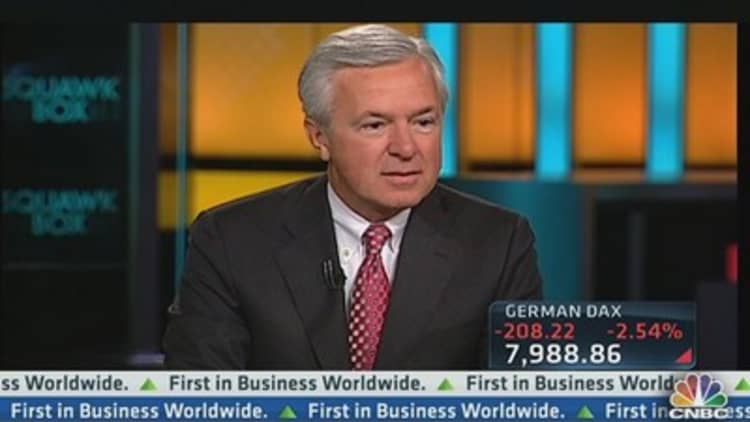For consumers, Wednesday's Federal Reserve announcement is a mixed bag.
Chairman Ben Bernanke said the Fed would leave the federal funds rate untouched at 0.25 percent. The committee will also continue its program of purchasing $85 billion in Treasury bonds and mortgage-backed securities each month, although Bernanke said it could taper off that purchase later this year.
(Read more: Taper Tipoff? Bernanke Hints Easing End Is Near)
Much of the banking and borrowing consumers do is tied to that federal funds rate, which means rates aren't rising anytime soon.
"The Fed would actually have to boost short-term rates, which they're unlikely to do until 2015," said Greg McBride, senior analyst for Bankrate.com.
The notable exception: Mortgage rates, which are tied to 10-year Treasury yields, have risen over the past month as those yields have, on the hints of Fed tapering. According to Freddie Mac, rates on a 30-year-fixed mortgage were 3.98 percent in early June, up from 3.35 percent a month earlier.
Still, even as the Fed maintains the status quo, consumers are seeing some shifts in offers that could affect their rates:
Credit Cards
Competition for customers with good or excellent credit has actually pushed rates on new credit cards down in recent months, said Odysseas Papadimitriou, chief executive of CardHub.com. The average rate for borrowers with excellent credit was 12.79 percent during the first quarter of 2013, down from 13.01 percent in the last quarter of 2012, according to the site. Rates also dropped slightly for business credit cards and student credit cards.
Continued economic improvement, combined with low rates, also makes lenders more willing to dangle zero-percent introductory offers. CardHub.com reports the average terms for no-interest balance transfer and purchase offers are both slightly more generous than a few months ago, with most cardholders getting a little more than 10 months' reprieve.
And if you're paying down a balance? Most cards do have variable rates, but they aren't going anywhere until that prime rate rises, he said. Federal law prohibits issuers from raising rates on existing balances unless the cardholder is more than 60 days delinquent.
Mortgages
House hunters and would-be refinancers may have missed their window of opportunity. Rates are likely to keep trending higher. Borrowers could see the rate for a 30-year fixed-rate mortgage hit 4.25 percent by next week, said Keith Gumbinger, vice president at HSH.com.
Consumers who are partway through the process have some ability to halt hikes. "If you've got a deal that works at 4, 4.25 percent, lock it in," he said. Ask about so-called float-down options, which, if rates drop, allows for that locked in rate to fall too. That can add several hundred dollars to the cost of the loan, but may work in borrowers' favor, he said.
Home Equity Loans and Lines of Credit
Rates aren't likely to budge much, because they're tied to the prime lending rate. But the recovering real estate market may help borrowers here. "Rising home prices has rebuilt equity," he said, and that makes it easier for some homeowners to get a home equity loan or line of credit.

Auto Loans
Summer car sales are in full force, including a wave of zero percent and other low-rate financing offers. There's no need to rush to the dealership, though—those offers aren't likely to disappear. "A lot of that is tied to better loan performance," said McBride. As the economy improves, fewer borrowers tend to default, which makes lenders more comfortable extending credit. Plus, overall rates are tied to that prime lending rate.
More From CNBC.com:
Automakers in High Gear For Sumer Car Deals
Drivers' Recourse Amid Chrysler Jeep Recall
Hot Summer May Make Consumers Sweat Over A/C Bills
Student Loans
"The student loan issue is really up in the air," said Joseph Hurley, a certified public accountant and chief executive of Savingforcollege.com. It's not a Fed trickledown: In 2007, Congress passed legislation offering a five-year rate reprieve that allowed students to take out loans at 3.4 percent instead of 6.8 percent, with a one-year extension approved in 2012. On July 1, those rates will reset unless Congress takes action.
Several proposals have been put forth that would extend the lower loan rate, or tie loan rates to Treasury or market rates, effectively pushing them higher. There's not much that borrowers can do but pay attention, Hurley said. "For this upcoming school year, the loan year starts on July 1," he said—loans can't be taken out earlier to skirt any rate change.
Other types of student loans are usually pegged to the federal funds rate or the Libor, meaning they're also unlikely to rise in the short term. That is, unless Congress passes new legislation that changes rates on more than Stafford loans, as some proposals have suggested.
Checking and Savings Accounts
Sorry, savers—no good news here. Rates on CDs, savings accounts and checking accounts aren't likely to move until the Fed raises interest rates, said McBride. A one-year CD yields 0.62 percent, while an interest checking account yields 0.50 percent.
But there are still opportunities to eke out a slightly higher return for emergency funds and other liquid savings. A recent Bankrate.com report found 56 high-yield accounts across the country offering an average 1.64 percent.
—By CNBC.com's Kelli B. Grant. Follow her on Twitter @KelliGrant.


